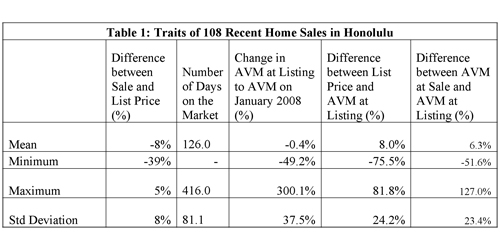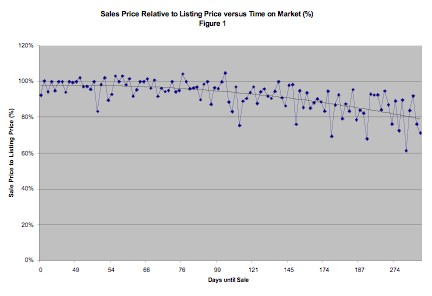These are extraordinary times in real estate markets and, especially perhaps, for homeowners seeking to sell their properties. Presumably, the goal for today’s homeowners wishing to sell is the same as in the past — get the best sale price possible. However, determining market value is probably more difficult today because of the uncertainties in the current housing and mortgage market.
Besides putting the house in mint condition for sale, the seller has two main choices. First, set the list price; and, set some type of reasonable goal for time on the market. Of course and as we will see, these two are related. What the seller does not control are market forces that influence the number of potential buyers and the prices they are willing to pay.
In an ideal and textbook situation, the seller would typically work with an expert such as a Realtor to set a list price and a reasonable expectation of the time it might take to sell. The decision would be informed by comparable and recent sales. Some modest appreciation might be expected since the purchase by the seller and, of course, the owner would place some value on what the owners consider to be the “unique” features of their homes.
Much research has been done in recent years to study financial decision making of consumers and others during periods of substantial uncertainty. What some find is that we often depart from the text book model and, at times, act “predictably irrational”, which is the title of a book authored by Dan Ariely (http://www.predictablyirrational.com/). Two other favorites of mine in this field are The Black Swan by Nicolas Taleb (http://www.fooledbyrandomness.com/) and Nudge by Richard H. Thaler and Cass R. Sunstein (http://yalepress.yale.edu/book.asp?isbn=9780300122237). What I have gleaned from these and other research on the broad topic is that we sometimes latch on to relatively simple benchmarks as a coping mechanism for the uncertainty. For example, we might choose to put substantial weight on the price we paid for the property in the recent past or the valuation provided in the not too distant past and before the “crisis” hit. We might also omit examination of some potentially valuable information to avoid the dangers of “information overload” by failing to monitor ongoing developments in the market once we set a listing price. This line of research has also highlighted the role of inflated expectations, which are sometimes very hard to overcome. For example, we may have built our future retirement plans in hopes of selling our house for a certain price, retiring to something less expensive, and using the profits as a supplement to our incomes. In this situation, letting go of these expectations can be very hard and consequential to the seller.
Offsetting the substantial rise in uncertainty are some potentially valuable tools. In particular, vast amounts of data are readily available to sellers that were inaccessible or very expensive in the past. One example is the explosion in the development of automated valuation models (AVM) to estimate the value of our homes. Consumer versions of these models are readily available at little or not cost via the internet. For example, see www.cyberhomes.com. These web sites offer sellers the opportunity to review a wide variety of benchmarks and information that supplement the traditional approaches and sources of information. This can be done at the time of the listing and during the time the market is on the market.
A small sample of recent home sales was reviewed to shed light on the impacts of these various factors. The analysis first focused on some potential drivers of the final sale price. These include the number of months the house was on the market, the initial list price, the list price relative to an AVM value developed at the time of the listing, and an AVM value produced in January 2008. It was also possible to include a proxy for evolving market conditions by comparing the AVM value at the time of listing to the one at the time of sale.
The sample consisted of 108 sales in 2009 in a certain zip code in Honolulu – 96825. The data were provided by Prudential Locations and the AVM values by Collateral Analytics. Here are some key traits of the sample (See Table 1):
- The average sale price was about 8 percent below the initial listing price.
- The properties were on the market for an average of about 4 months (126 days) and ranged from 0 days to 416 days.
- The AVM at listing was, on average, about the same as the AVM estimated on January 2008, but there was substantial variation around the average and the average was heavily influenced by some extreme positive outliers. In fact, most involved a reduction in the two AVM values and over 40 percent experienced double digit declines in the values of their homes according to the two AVMs in the period between January 2008 and the time the home was listed.
- The initial listing price was about 8 percent higher than the AVM at the time of listing. Again, the distribution around the average was substantial. About two-thirds had listing prices in excess of the AVM and one-third were above more than 15 percent higher than the AVM.
- The AVM changes from the time of listing until September 2009 were about averaged about 6 percent higher, on average. Variation around the mean was substantial.
I investigated a wide variety of simple statistical models to explain the ultimate difference between the sold price and the initial listing price (row 1 in Table 1). The factors in Table 1 and others were investigated to see whether they had much impact on the ultimate sale price. The only dominant factor that emerged from this examination is the time on the market. Roughly, every additional month on the market led to about a 2 percent decline in the sale price relative to the initial listing price. The relationship is summarized in Figure 1.
Several other factors were considered. The initial excess of the list price relative to the AVM value at the time of the listing is one of particular interest. The statistical analysis confirmed a small negative impact on the sold price relative to the initial listing; increasing the excess of the list price over the AVM by 10 percent only reduced the ultimate sale price by just over 1 percent. The change in the AVM value from the time of listing to the time of sale also had a small and negative impact upon the ultimate sale price. Higher price properties did appear to take a bigger hit in this sample than the rest; the a property with a listing price among the top ten most expensive properties suffered declines 6 percent larger than the rest of the population.
Given the importance shown by time on the market as a driver of the final sale price, some other analysis was done to see whether the influence of the other factors that affect time on the market could be detected. I viewed the change in the AVM at the time of the sale relative to the AVM at the time of the listing as an indicator or proxy of what was happening in the market for the particular house once it was listed. In fact, declines in this ratio did have a modest positive impact for many of the properties; a ten percent decline led to an increase on time on the market by a little over one week. However, those properties in which house prices appear to be in steep decline were hit much harder. For example, those with the largest price declines in the sample were on the market for almost three months longer than the others. We take this as a sign of the importance of keeping abreast of market conditions once the house is listed. If the market is turning south, then some adjustment in price may be appropriate.
This data set presented an interesting opportunity to examine one other potentially important factor – do home sellers “hang on” to previous benchmarks in determining the initial listing price? We find some modest evidence that they do. We examine the change in the AVM value from January 2008 until the time the house is listed for sale. Those with large declines are the candidates for the label “Stubborn Sellers” because these are the ones most likely disappointed by the change or who may have lost an important benchmark in determining current market value – the value in the recent past. In fact, the correlation between the percent decline in the two AVMs and the premium of the list price over the current AVM is 45 percent; that is, those who experienced a substantial decline in value tended to set a list price well in excess of the current AVM. The pattern is particularly strong among those that experienced the biggest drop in value prior to listing. This group experienced an average price decline of about 36 percent in value and they listed their home at, on average, 30 percent above the AVM value at the time of listing (See Figure 2). Surprisingly, the actual decline in the final sold price relative to the initial list price for this group turned out to be not much different than the rest of the population. So even here the picture is hardly crystal clear.
This is a relatively simple examination of a highly complex issue facing prospective home sellers in today’s market. At a minimum, it pertains to only one particular zip code in one city and a small number of sales. However, it seems to confirm a more widely held view – those properties than take a long time to sell generally do worse than those that sell relatively quickly. Perhaps there are things that the seller and broker can to do speed up this process. Although the evidence in this particular case study is well short of definitive, our hunch and instinct suggests that sellers would likely do well to set a price close to high quality appraised values and then to monitor the market once the price has been set. Be wary of holding on to prices from 2007 or 2008 without strong evidence since market conditions in many places have declines. Also, stay in touch with your advisors and consult the enormous amount of AVM information available to sellers via the internet, which might help you decide to lower your price and avoid the damage done by a lengthy time on the market.
November 12, 2009
James R. Follain, Ph.D.


